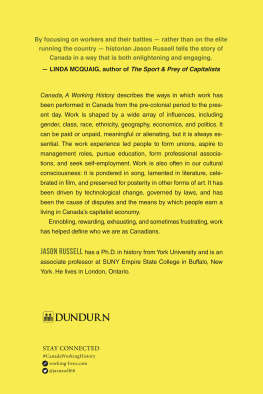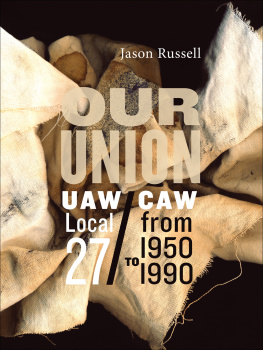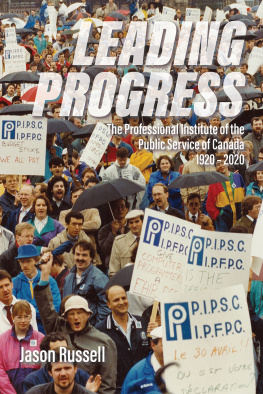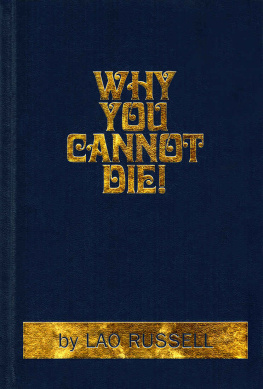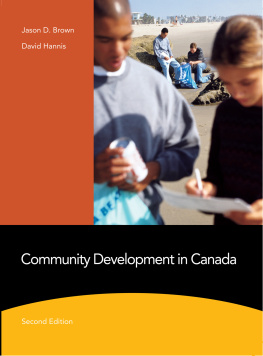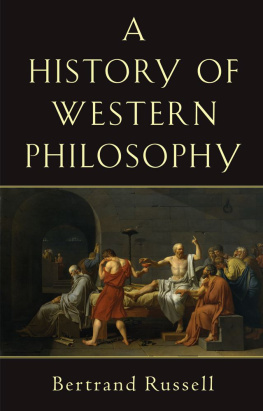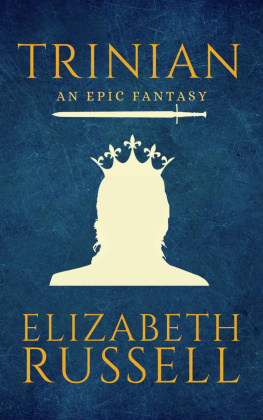Jason Russell - Canada, a Working History
Here you can read online Jason Russell - Canada, a Working History full text of the book (entire story) in english for free. Download pdf and epub, get meaning, cover and reviews about this ebook. year: 2021, publisher: Dundurn Press, genre: Politics. Description of the work, (preface) as well as reviews are available. Best literature library LitArk.com created for fans of good reading and offers a wide selection of genres:
Romance novel
Science fiction
Adventure
Detective
Science
History
Home and family
Prose
Art
Politics
Computer
Non-fiction
Religion
Business
Children
Humor
Choose a favorite category and find really read worthwhile books. Enjoy immersion in the world of imagination, feel the emotions of the characters or learn something new for yourself, make an fascinating discovery.
- Book:Canada, a Working History
- Author:
- Publisher:Dundurn Press
- Genre:
- Year:2021
- Rating:5 / 5
- Favourites:Add to favourites
- Your mark:
- 100
- 1
- 2
- 3
- 4
- 5
Canada, a Working History: summary, description and annotation
We offer to read an annotation, description, summary or preface (depends on what the author of the book "Canada, a Working History" wrote himself). If you haven't found the necessary information about the book — write in the comments, we will try to find it.
Canada, a Working History — read online for free the complete book (whole text) full work
Below is the text of the book, divided by pages. System saving the place of the last page read, allows you to conveniently read the book "Canada, a Working History" online for free, without having to search again every time where you left off. Put a bookmark, and you can go to the page where you finished reading at any time.
Font size:
Interval:
Bookmark:

JASON RUSSELL

Copyright Jason Russell, 2021
All rights reserved. No part of this publication may be reproduced, stored in a retrieval system, or transmitted in any form or by any means, electronic, mechanical, photocopying, recording, or otherwise (except for brief passages for purpose of review) without the prior permission of Dundurn Press. Permission to photocopy should be requested from Access Copyright.
Publisher and acquiring editor: Scott Fraser | Editor: Michael Carroll
Cover designer: Laura Boyle
Cover image: Punch clock: shutterstock.com/Somphop Krittayaworagul | timecard: shutterstock.com/Martin Janecek
Printer: Marquis Book Printing Inc.
Library and Archives Canada Cataloguing in Publication
Title: Canada, a working history / Jason Russell.
Names: Russell, Jason, 1968- author.
Description: Includes bibliographical references and index.
Identifiers: Canadiana (print) 20200391534 | Canadiana (ebook) 20200391631 | ISBN 9781459746022 (softcover) | ISBN 9781459746039 (PDF) | ISBN 9781459746046 (EPUB)
Subjects: LCSH: WorkSocial aspectsCanadaHistory. | LCSH: LaborCanadaHistory.
Classification: LCC HD6957.C3 R87 2021 | DDC 306.3/60971dc23

We acknowledge the support of the Canada Council for the Arts and the Ontario Arts Council for our publishing program. We also acknowledge the financial support of the Government of Ontario, through the Ontario Book Publishing Tax Credit and Ontario Creates, and the Government of Canada.
Care has been taken to trace the ownership of copyright material used in this book. The author and the publisher welcome any information enabling them to rectify any references or credits in subsequent editions.
The publisher is not responsible for websites or their content unless they are owned by the publisher.
VISIT US AT
 dundurn.com
dundurn.com
 @dundurnpress
@dundurnpress
 dundurnpress
dundurnpress
 dundurnpress
dundurnpress
Dundurn Press
1382 Queen Street East
Toronto, Ontario, Canada
M4L 1C9
For my son, Thomas Liepins Russell
T his book is about how work in Canada changed from the period of European colonization to 2020. It is intended to provide a broad overview of major developments and trends in Canada and show how work was shaped by wider influences in Canadian society. Work is a central human activity that has innate value whether or not it involves receiving compensation. The historical development of work in Canada parallels the nations progress. Workers in their many times, places, and occupations made Canada, and their work is ongoing.
The narrative is divided into six parts, which cover time periods of varying scope. Part I describes European colonization to the years before Confederation in 1867. Canada was initially a collection of disparate colonies and long-established Indigenous nations that was formed into a country, with the different political actors involved showing varied levels of enthusiasm for the new nation. Canadas ties with Britain remained strong during the long period from colonization to Confederation, and the nation was gradually formed within the context of an occasionally fraught relationship with the United States.
Part II details a shorter period from Confederation to the 1930s. Canada experienced profound change between 1867 and 1939. Canadian workers most importantly left their civilian jobs in droves in 1914 to enlist in the army to fight in Europe. Many of them did not return to resume their civilian lives. Canadians built a railway from coast to coast, welcomed scores of immigrants, built new cities and factories, and experienced industrialization. They also formed workers organizations, created new business structures, and combined themselves into professions.
Part III covers the critical period from 1945 to 1969. Canada was much different at the end of the Second World War than when the conflict started. The Great Depression drove unemployment to record heights in the 1930s, and the war eliminated it in short order. Canada became a major contributor to the war effort. Women streamed into industrial jobs in large numbers for the first time. Unions were inspired by the struggles waged by their American comrades, and they gained the right to engage in legal collective bargaining.
The 1950s and 1960s were prosperous decades for many but not all Canadians. Wages often met or exceeded the cost of living. Working-class people were able to own their homes rather than rent. A vibrant consumer culture shaped peoples identities and also furnished a wide array of new goods and services. This was part of the era of the Cold War ideological struggle, and work and employment were touched by it. Women demanded social change in the 1960s, and the structure of families was transformed. Important social programs were introduced that immeasurably improved the lives of working people.
Part IV examines work in Canada in the 1970s and 1980s. The 1970s were a sort of socio-economic interregnum between the 1960s and 1980s, but they still brought substantial change to work and labour. Women became an ever-larger percentage of unionized workers, especially in the public sector. A crucial legislative change in the late 1960s gave federal public sector workers the right to formally unionize and engage in collective bargaining, and that right spread across the provinces, as well.
The 1970s were an important economic turning point for workers of all types. Wage increases gradually stopped providing expanded standards of living. The postwar baby-boom generation graduated from high school and post-secondary education and entered the paid workforce. Media culture continued to include representations of working life.
Part V encompasses the 1990s and 2000s. The pace of change in working life markedly accelerated during those decades. There were major labour struggles, and governments made deliberate policy decisions that did things like deregulate areas of the economy that harmed workers. Canada experienced early globalization, and its economy became even more oriented toward services and away from manufacturing. The Cold War ended during this period, but its demise did not bring significant benefits to working Canadians.
Part VI discusses the period from the turn of the millennium to 2020 and beyond. Canadians approached the end of the 20th century with mixed feelings of anticipation and trepidation. The new century brought enormous opportunity for workers who were well educated and possessed marketable skills but also came with uncertainty and upheaval for other workers. It almost came to seem as if Canada were going back to the preSecond World War period, with the growing prevalence of non-standard work arrangements.
Work continued to bifurcate along gender, racial, and ethnic lines into the new century. Women did not earn as much as men for doing equal work, and immigrants and people of colour were often relegated to low-wage jobs. Technology permeated virtually every workplace, but it was used for control and surveillance as much as to enhance profitability.
Font size:
Interval:
Bookmark:
Similar books «Canada, a Working History»
Look at similar books to Canada, a Working History. We have selected literature similar in name and meaning in the hope of providing readers with more options to find new, interesting, not yet read works.
Discussion, reviews of the book Canada, a Working History and just readers' own opinions. Leave your comments, write what you think about the work, its meaning or the main characters. Specify what exactly you liked and what you didn't like, and why you think so.

